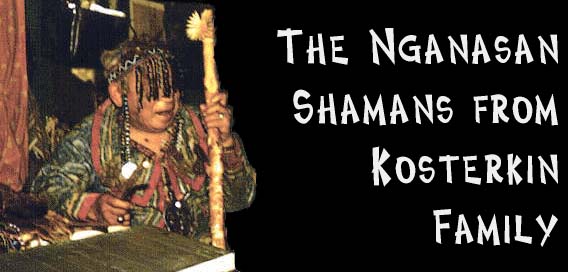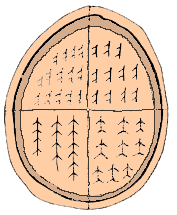
ISBN 9985-851-98-6
All rights reserved
© Folk Belief and Media Group of the Estonian Literary Museum
© Aado Lintrop
Dyukhade Kosterkin
Demnime Kosterkin
Tubyaku Kosterkin
Dyukhade Kosterkin
Dyukhade was not the first shaman in the Kosterkin family. According to the legend told by Boris, the youngest son of Dyukhade, all shamans in their family stemmed from the ancient tribal shaman who, together with his children, survived from a great epidemic. The eldest son of this shaman had a daughter, Neiming. Neiming gave birth to a child - a snow-white boy with a long nose and big eyes. Neiming said: "I want to go away with my son and stand on my own feet. Let my son's name be Lambie (the Eagle). Let him also be called the Great and the Tall. His father was like a great eagle - the Eagle god." They began to live on their own. Lambie became a very powerful shaman. When he shamanised he turned totally invisible. Some people believe that the shaman gift of the Kosterkin family springs from Neiming, but Boris said that the ancestor of Dyukhade was Neiming's younger cousin Syry'a (the White), also a great shaman. According to another legend told to A. Popov, there was a wolf-tailed shaman among Dyukhade's ancestors. "A wolf began to kill reindeer. Nobody could catch it. At last a shaman said: "I'll get hold of it. The wolf, like other animals, does also have its mother." He shamanised three days running, then said: "I put the wolf into my wife, you'll see what kind of child will be born." A wolf-tailed child - the grandfather of Dyukhade - was born. He became a great shaman and lived all his life with the tail." Dyukhade himself told: "When I was in my mothers womb on the fifth month of her pregnancy, the Smallpox god find me out. My mother became a wife of the Smallpox in her dream. After waking she said that her future child would become a shaman by the aid of the Smallpox and that she herself would die after the birth." Dyukhade had three wives, three shaman costumes and three drums. During his initiatory visions he met the Lord of the Tree who gave him the branch with three forks and bade him make three drums from it. "Let you have three wives, who will watch over your drums," he said. Each drum was for a special ceremony - the first for shamanising women in childbirth, the second for upper world journeys, and the third for descending to the underworld. Dyukhade's daughter Nobopte (or Nobupti'e) was a powerful shaman, too. Her chief helping spirit was barusi - a mythical one-eyed, one-armed, one-legged creature (demonised dead). Whereas barusi has been considered an evil spirit, people seldom looked for Nobopte's aid. Some of them told that Nobopte had even got a child with barusi, but some believed that after marrying Nobopte his father put her barusi into one of his helping spirits. Dyukhade's sons Tubyaku (1921-1989) and Demnime (1926-1980) were also shamans. In 1977 the Estonian movie team leaded by Lennart Meri visited Demnime in his camp near the Ust-Avam village. Click here to see photos about this visit and to read some information regarding Demnime as a shaman. In 1989 Eugene Helimski from Moscow, Yuri Sheikin, and Olga Dobzhanskaya from Novosibirsk, Triino Ojamaa and Aado Lintrop from Tartu visited Tubyaku Kosterkin in Ust-Avam village. Among the rest materials they recorded two short shaman rites. With the aid of Nadezhda Kosterkina, the daughter of Tubyaku, E. Helimski translated texts of this rituals and published them in Taimyrskij etnolingvisticheskij sbornik (Moscow 1994). Click here to know more about Tubyaku Kosterkin. |
One of Dyukhade's drums in back view.
Back to the Incantator
Mail to aado@haldjas.folklore.ee
